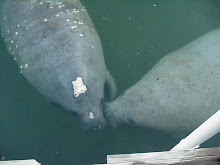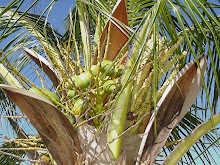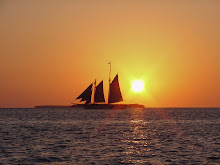2013 marks 500 years of history and diverse cultural heritage in Florida. This is a claim no other state in America can make.
Viva Florida 500 is a statewide initiative led by the Florida Department of State, under the leadership of Governor Rick Scott, to highlight the 500 years of historic people, places and events in present-day Florida since the arrival of Juan Ponce de Leon to the land he named La Florida in 1513. While Florida's Native American heritage dates back more than 12,000 years, Spain's claim in 1513 began a new era.
The Viva Florida 500 commemoration is ongoing throughout 2013, and includes more than 200 events statewide.
The Colonel and I participated in one of the events on Saturday, February 16th. The event was entitled, At First Contact: A Fierce People. The 'Fierce People' are also known as the Calusa Indians.
The interactive living history event featured a re-created Calusa village on the shores of Charlotte Harbor and was a Charlotte County Historical Center event.
The Calusa Indians had a complex culture based on estuarine fisheries rather than agriculture and their territory encompassed most of southwest Florida and may have included the Keys. It is believed that there were nearly 20,000 Calusa at time of contact with the Spanish explorer Juan Ponce de Leon.
The Calusa were mound builders. Their mounds were made of shell or sand. There are still mounds in the area today. Their diet consisted of all kinds of fish, shellfish, turtles, alligator, deer, gathered fruits, nuts, wild plants and berries.
The Calusa lived in large communal houses and the chief's (the Spanish called him King Carlos) house was built on a large earthwork or shell mound.
As recorded by the Spanish, the Calusa wore very little clothing. Men would wear a loin cloth of woven palm fronds or sometimes deer skin. Women were topless and wore skirts of woven moss or palm fronds. Any jewelry was made of shells or seeds. The chief's wife may have worn precious stones or pearls.
Both men and women painted their bodies. No evidence of tattooing was recorded. Often the painting was not used as decoration but rather as insect repellent. The paint was made of mud and different ground plants.
The Calusa believed that three supernatural beings ruled the world. The most powerful ruler governed the physical world. The second ruled human governments and the third helped in wars; choosing who would win. They also believed that people had three souls: a person's eye, shadow and reflection.
In 1521 Juan Ponce de Leon organized a colonizing expedition to La Florida with two ships (he had been to La Florida before in 1513 looking for the Fountain of Youth). He had 200 men with him as well as 50 horses and other domesticated animals (cows and pigs whose descendants are still here). The expedition landed in the Calusa territory which the Calusa did not take to kindly. The Indians attacked and wounded Ponce de Leon in the thigh with a poison arrow. After the attack the Spanish sailed to Havana, Cuba where Ponce de Leon later died from his wound.
What eventually happened to the Calusas? They died out in the late 1700's. Enemy tribes from Georgia and South Carolina began raiding the Calusa territory. Some Calusa were captured and sold as slaves. In addition diseases such as smallpox and measles brought by the Spanish explorers wiped out entire villages. It is believed that remaining Calusas went to Cuba when the Spanish gave Florida to the British in 1763.
Back to the Viva Florida 500 interactive living history event featuring the re-created Calusa Village...
The Colonel played the part of the Calusa chief, King Carlos and I played the part of his queen. The Spanish did not record a name for her. They did say that she was beautiful (I could do beautiful).
We had guidance from an archaeologist about what our costumes should generally look like (we also looked at pictures). The grass skirts, palm fronds and shell necklaces were supplied by the historical center, the rest was up to us.
The Colonel and I knew our costumes had to be well done and similar, as we were portraying the king and queen (but still not cost too much). Our shirts had to be a tan color to simulate skin. We, especially I, could not go topless like the real Calusa. We were glad we had long sleeves on as it was windy and a bit cool at times.
I went to Beall's Outlet and found our shirts for $7 each. We took our shirts out to the garage and taped off a design that was similar to the ones we saw in pictures of Calusa body painting and then we spray painted the shirts. They turned out nicely.
The Colonel found a black wig to wear from the local party shop and I had him color my hair black with a temporary color that washes out in 28 shampooings (so the box says). I have a long black wig but did not want to wear it and have all that hair blowing in my face (and it would have). I have gotten many reactions from family and friends about this new, darker hair color. Most agree that it just isn't me, that it is too dark. The Colonel likes it.
We had to cut our grass skirts down to size and length. Our living room floor looked like Big Bird's nest.
My mother-in-law had given me a pair of earrings the week before the event and I glued a shell on each one to wear as part of my queenly costume. We had some face paint stashed in our Halloween items and used it to finish off our Calusa look.
The event began at 10:00 a.m. and ended at 2:00 p.m. There were about four newspaper reporters there taking pictures and asking questions. Our picture made the front cover of the Tampa Tribune (below).
The reporters and visitors to our Calusa village were treated to the Black Drink Ceremony. In this ceremony only men from the tribe could drink the Black Drink. The Calusa drink was made from a type of holly berry that was fermented. It would cause vomiting and hallucinations. The ceremony would be performed for special reasons like the burial of a warrior or getting ready for war. As queen, I would pour the Black Drink (we used cold coffee) into a smaller shell and offer it to the king and then the other men of the tribe.
We also re-enacted the welcoming of a man from the Tocobago Tribe. The Tocobago Indians lived in the Tampa area. Our visiting Tocobago presented himself first to The Colonel and then to me. He got down on one knee and held his hands cupped upwards. The Colonel and I cupped our hands downwards into the visitor's hands. We welcomed those who came to the event in that manner too.
Our visiting Tocobago demonstrated how to knap arrowheads. The Calusa Indians did not make tools out of stone, they used shells. They would often trade with other tribes for stone tools.
In our Calusa Village we also had a charnel house. The Calusa put their dead on platforms until the flesh fell away from the bones and then they would bury the skeleton in a sand or shell mound. The body would be guarded by a boy or man until it could be buried.
We also had a barbacoa in our village. It is what the Calusa used to cook their food on and where the word Bar-B-Que comes from. The barbacoa and the charnel house platform looked similar and when the Spanish first saw the Calusa they thought they were cannibals which they were not.

One of our warriors hunted for fish with an atlatl. An atlatl is a device for throwing a projectile. It is a rod or board that has a hook at the end that keeps the projectile in place until it is released. The atlatl increases the power and distance of a throw.
In addition to our inter-active village, the event also had craft items that children could make. The children could make small pinch pots and decorate them with shells and sharks teeth. They could make shell necklaces and color Calusa masks made out of paper.
The Colonel's parents came to our Calusa village. My Favorite Father-In-Law took some of these pictures for me (had to stay in character didn't I). We welcomed The Colonel's mother in the Calusa tradition.
My Mother-In-Law tried her hand at the atlatl. The Colonel couldn't believe it. She did well.
The Colonel and I were very happy to help the historical center with its Viva Florida 500 event. We had fun getting our costumes together, portraying the Calusa king and queen and being part of something that is a statewide initiative....that is pretty cool.





































































